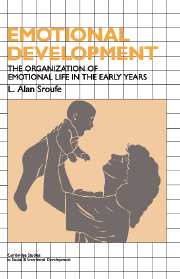Book contents
- Frontmatter
- Contents
- Preface
- Part I The nature of emotional development
- Part II The unfolding of the emotions
- 4 An organizational perspective on the emergence of emotions
- 5 The development of joy: a prototype for the study of emotion
- 6 The development of fear: further illustration of the organizational viewpoint
- 7 The interdependence of affect and cognition
- 8 Meaning, evaluation, and emotion
- Part III Emotional development and individual adaptation
- References
- Index
5 - The development of joy: a prototype for the study of emotion
Published online by Cambridge University Press: 16 September 2009
- Frontmatter
- Contents
- Preface
- Part I The nature of emotional development
- Part II The unfolding of the emotions
- 4 An organizational perspective on the emergence of emotions
- 5 The development of joy: a prototype for the study of emotion
- 6 The development of fear: further illustration of the organizational viewpoint
- 7 The interdependence of affect and cognition
- 8 Meaning, evaluation, and emotion
- Part III Emotional development and individual adaptation
- References
- Index
Summary
Certain smiles are not triggered by social events, are not conditionable, and are related to REM states of drowsiness. Other smiles are clearly responses to caretakers, appear to be anticipatory reactions, and appear at times of high alertness. The latter smiles are inferred to be emotional, the former are not.
Plutchik (1983)The developmental course of pleasure and joy is revealed by decades of solid research on infant smiling, which focused on its occurrence, its progressive changes in form, and its evolving meaning. Perhaps more than is the case for any other problem area, research focused on the nature and significance of infant smiling and laughter has revealed fundamental developmental processes. These processes are central to understanding normative affective development, individual emotional life, and the ties between the two. One cannot, for example, understand that at the core of smiling is arousal regulation and miss the importance of this process for studying individual differences.
There are no doubt several reasons for the important contribution made by research on smiling. First, much of the research carried out in the 1960s and 1970s was faithfully descriptive, a necessary cornerstone for any body of meaningful developmental research. Second, studies were addressed to ages across the span of infancy, often employing a longitudinal format.
- Type
- Chapter
- Information
- Emotional DevelopmentThe Organization of Emotional Life in the Early Years, pp. 77 - 100Publisher: Cambridge University PressPrint publication year: 1996



